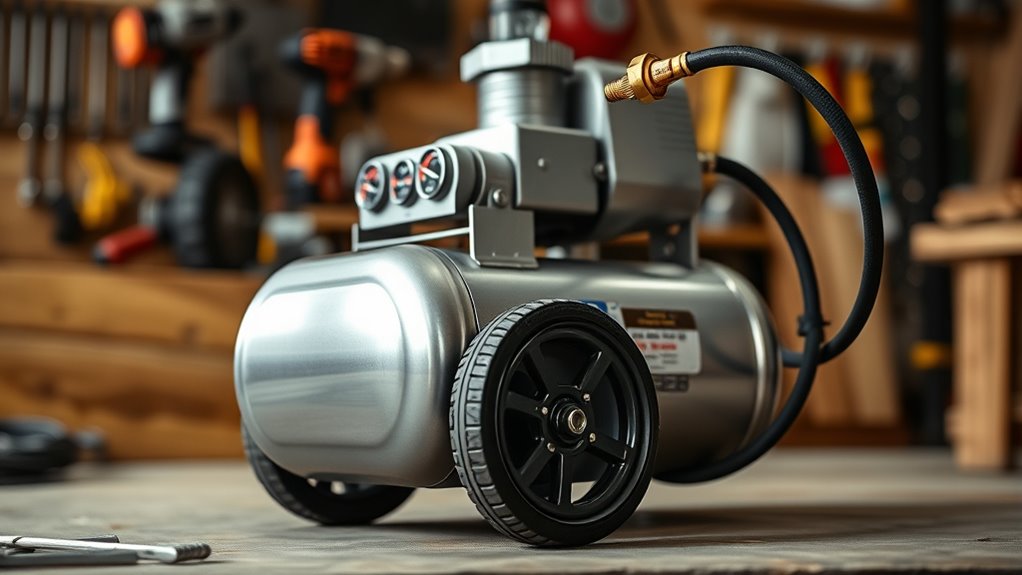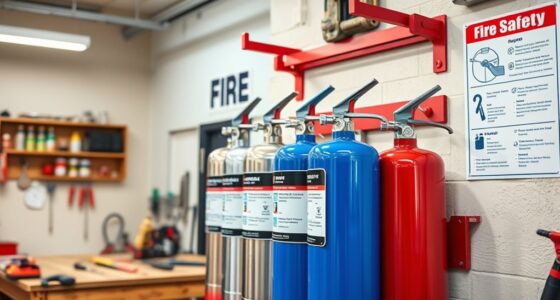When choosing an air compressor for DIY projects, consider the pressure rating, typically between 90 and 150 PSI, to power your tools effectively. Match this with a tank size suitable for your needs—small for portability or larger for longer work sessions. Balance between pressure and tank capacity to avoid frequent cycling or lack of power. Think about how often you’ll move or use the compressor, and remember that proper maintenance keeps it performing well. To get a clearer picture, keep exploring the key factors involved.
Key Takeaways
- Match compressor pressure ratings (90-150 PSI) to your specific DIY tools and tasks.
- Choose tank size based on project duration and portability needs; smaller for mobility, larger for continuous use.
- Balance pressure and tank capacity to ensure consistent airflow and avoid frequent cycling.
- Consider your work environment and frequency to select a portable, lightweight compressor or a stationary unit.
- Prioritize regular maintenance to ensure safety, efficiency, and long-term performance of your compressor.

Choosing the right air compressor is essential for successfully tackling your DIY projects, whether you’re inflating tires, spray painting, or powering pneumatic tools. One of the first things to consider is the pressure ratings, which determine how much air pressure the compressor can deliver. For most home projects, a compressor with a pressure rating of around 90 to 150 PSI (pounds per square inch) will suffice. This range provides enough power for common tasks like inflating tires, operating nail guns, or spray painting without overwhelming your equipment or causing safety concerns. If you plan to work on more demanding projects or use multiple tools simultaneously, look for a unit with higher pressure ratings to ensure consistent performance and avoid frequent pauses for the compressor to catch up.
Tank sizes are equally important, especially if you want to avoid constant cycling or need a steady flow of compressed air. Smaller tanks, such as 1 to 6 gallons, are lightweight and easy to store, making them ideal for quick jobs or tight spaces. However, they tend to run out of air quickly, causing the compressor to turn on more frequently, which can wear down the motor faster over time. Larger tanks, like those 20 gallons or more, provide a greater air reserve, reducing the need for the compressor to cycle on and off repeatedly. This results in more consistent airflow, especially during prolonged tasks like spray painting large surfaces or running multiple tools at once. When selecting tank size, think about how long you’ll use your tools in a session and whether portability is a concern. If you need a portable option, a smaller tank is easier to move around; but if you prioritize continuous power and efficiency, a larger tank is a better choice.
Balancing pressure ratings and tank size is key. A higher-pressure compressor with a small tank may deliver impressive PSI but might not sustain longer jobs without frequent restarts. Conversely, a larger tank with lower pressure ratings may provide ample airflow but might not have the power needed for certain pneumatic tools. Keep your specific project requirements in mind, and choose an air compressor that offers the right combination of pressure capacity and tank capacity. Proper maintenance and care of your compressor also ensure long-term performance and safety, saving you time and hassle later, making your home workshop more efficient and enjoyable.
Frequently Asked Questions
What Is the Ideal Noise Level for a DIY Air Compressor?
The ideal noise level for a DIY air compressor is around 60 to 70 decibels, ensuring manageable noise levels for your workspace. Lower noise levels improve compressor quietness, making your projects more comfortable and less disruptive. If you prefer a quieter environment, look for models with noise levels under 60 decibels. This balance allows you to work efficiently without excessive noise, keeping your workspace safe and pleasant.
How Energy-Efficient Are Different Types of Air Compressors?
Different types of air compressors vary in energy efficiency. You’ll find that inverter and scroll compressors typically have higher efficiency ratings, meaning they use less energy for the same workload. Reciprocating compressors often consume more energy due to their design. By comparing efficiency ratings, you can choose a model that minimizes energy consumption, helping you save on electricity bills and reduce environmental impact while completing your DIY projects effectively.
Can I Use a Portable Air Compressor for Heavy-Duty Tasks?
You might find that a portable air compressor struggles with heavy-duty performance, as its limitations often stem from smaller tanks and lower power. While it’s convenient for quick tasks, pushing it into heavy-duty territory can lead to overheating or insufficient airflow. Think of it as a tool designed for lightweight work; if you need consistent, reliable heavy-duty performance, investing in a larger, more powerful compressor is the smarter choice.
What Maintenance Is Required to Prolong Compressor Lifespan?
To prolong your compressor’s lifespan, you need to perform regular maintenance. Check the oil levels regularly and top them off or change the oil as recommended by the manufacturer. Replace filters periodically to prevent dust and debris from clogging the system. Keep the compressor clean and dry, and inspect hoses for wear or leaks. Proper maintenance guarantees your compressor runs smoothly and lasts longer, saving you money and hassle.
Are There Safety Features I Should Look for in a Compressor?
They say safety first, and that’s especially true when choosing a compressor. Look for safety features like automatic shut-off, pressure relief valves, and thermal overload protection to guarantee compressor safety. These features help prevent accidents and damage, giving you peace of mind during your DIY projects. Prioritizing safety features means you’re protecting yourself, your tools, and your workspace—making your work safer and more efficient.
Conclusion
Remember, the right air compressor is the foundation of successful DIY projects. Take the time to assess your needs, compare features, and choose wisely. As the saying goes, “A stitch in time saves nine,” so investing in the right equipment now prevents headaches later. With the proper compressor, you’ll tackle projects with confidence and ease. Don’t rush your decision—your future DIY self will thank you for it.









